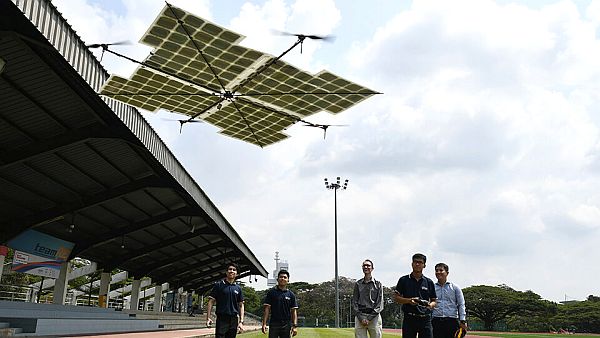Podcast: Play in new window | Download (Duration: 24:00 — 16.6MB)
Subscribe: Google Podcasts | Email | RSS
A solar-powered quadcopter, a drone assisting in the study of whales, using drones to fight cocaine, capturing intruder drones, improving crop yields with a drone service, and a quadcopter with legs.

A solar-powered quadcopter. (From the left.) Mr Yeo, Mr Goh, Assoc Prof Danner, Mr Kuan and Mr Teo. Courtesy National University of Singapore.
UAV News
Asia’s first fully solar-powered drone lifts off
This prototype solar-powered quadcopter was developed by the engineering students at the National University of Singapore. It uses 148 silicon solar cells on a four square meter carbon fiber frame. The prototype weighs and can be controlled by remote or fly autonomously.
100% solar-powered quadcopter drone
The Scientists Who Study Whale ‘Defecation Events’
Oregon State University’s Marine Mammal Institute is studying whale feces because analysis allows them “to document the reproductive and stress hormone variation of gray whales.” When a gray whale defecates, the result is a brown plume in the water. It dissipates fast and there isn’t much time to collect a sample. The researchers are using drones to follow the whale while they watch for the plume. A small chase boat then arrives to collect the sample.
Columbia is now using an army of drones to poison cocaine crops
The Colombian government is testing ten drones that spray herbicide to kill crops. Loaded, the drones weigh about 50 pounds. The herbicide application is more precise than spraying from an airplane and less expensive.
The DroneHunter knocks killer drones out of the sky
Fortem Technologies is developing the DroneHunter that captures intruder drones. In an NBC video report on this Counter Unmanned Aircraft System (C-UAS), Fortem CEO Timothy Bean said the DroneHunter, “patrols the airspace, detects any unwanted objects in the airspace, enemy drones or other robotics, pursues them, and then safely captures them and tows them away to a safe location.” DroneHunter autonomously detects intruder drones, shoots a net at 80 MPH to a target drone up to 25 feet away, captures the enemy drone and carries it away.
Company promotional video (see the NBC report for the DroneHunter in action):
Fortem Technologies: Enabling the Benefits of a Drone World
Pollen Systems Launches Drone-Based Data and Analysis Solution to Improve Vineyard and Crop Yields
Pollen Systems Corporation in Bellevue, Washington announced a managed service that helps farms and vineyards monitor their crops. Subscribing farms and vineyards get weekly visits by a certified Drone Technologist. The Pollen Scout UAV captures RGB, NDRE (Normalized Difference Red Edge), and NDVI (Normalized Difference Vegetation Index) images. These help farmers identify issues with crop growth, irrigation problems, pests, and diseases. The Pollen Scout is already flying at several early adopter vineyards in Washington State.
Watch this delightful aerial robot dance with its dangly legs
University of Tokyo researchers have developed a quadcopter with spindly legs. The Aerial-Biped senses the forward velocity of the quadcopter and automatically manipulates the legs through servos – giving it a dancing-like motion. Paper: Aerial-biped: a new physical expression by the biped robot using a quadrotor. Abstract:
“We present a biped robot which can move agiler than conventional robots. Our robot can generate bipedal walking motion automatically using the proposed method. By using a quadrotor for balance and movement it is possible to make an agiler movement, and generate a gait interactively and in real time according to the motion of the quadrotor using the optimized control policy of the legs. Our system takes the velocity of the quadrotor as an input and legs motions are produced so that the velocity of the foot in contact with the ground to zero, and bipedal walking motion is generated. The control policy is optimized using reinforcement learning with a physics engine.”
Aerial-Biped: a new physical expression by the biped robot using a quadrotor
